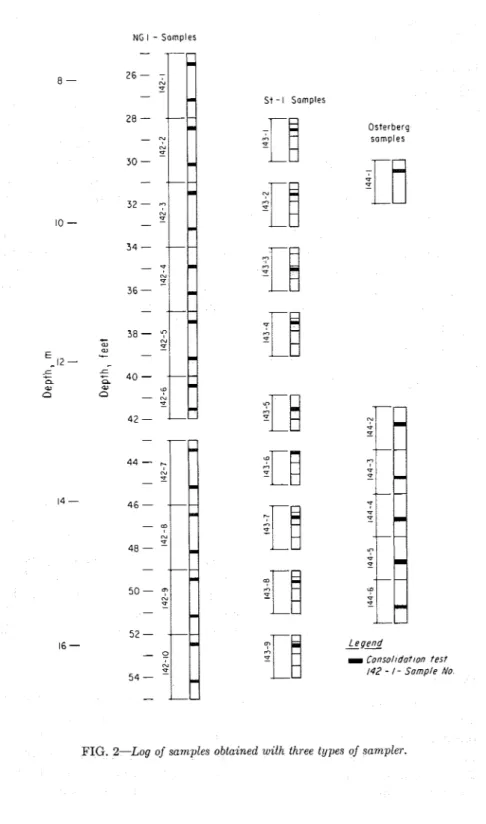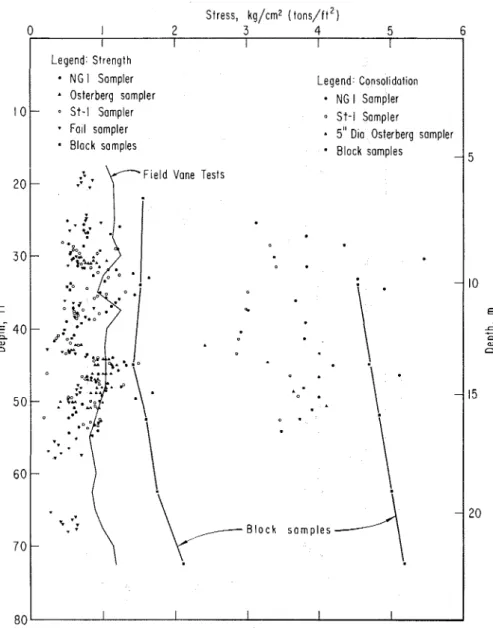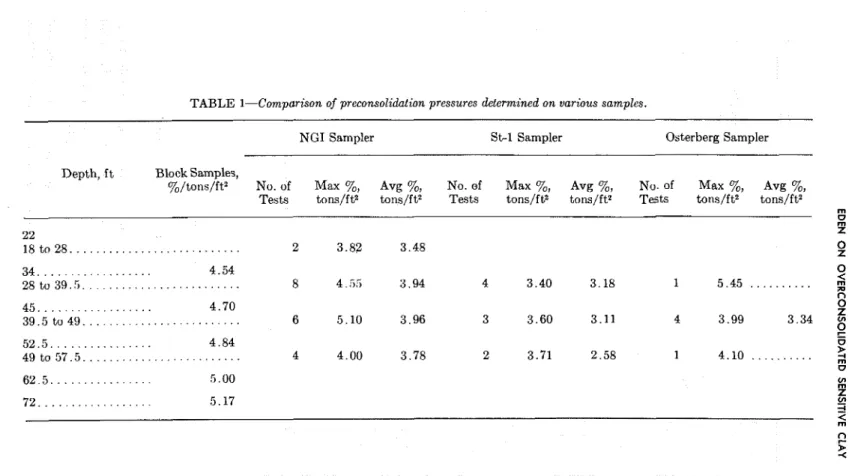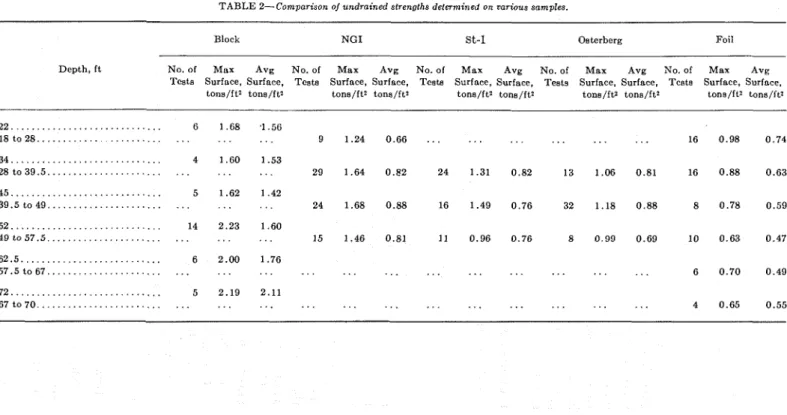Publisher’s version / Version de l'éditeur:
ASTM Special Technical Publication, 483, pp. 132-142, 1971-01-01
READ THESE TERMS AND CONDITIONS CAREFULLY BEFORE USING THIS WEBSITE.
https://nrc-publications.canada.ca/eng/copyright
Vous avez des questions? Nous pouvons vous aider. Pour communiquer directement avec un auteur, consultez la première page de la revue dans laquelle son article a été publié afin de trouver ses coordonnées. Si vous n’arrivez pas à les repérer, communiquez avec nous à PublicationsArchive-ArchivesPublications@nrc-cnrc.gc.ca.
Questions? Contact the NRC Publications Archive team at
PublicationsArchive-ArchivesPublications@nrc-cnrc.gc.ca. If you wish to email the authors directly, please see the first page of the publication for their contact information.
NRC Publications Archive
Archives des publications du CNRC
This publication could be one of several versions: author’s original, accepted manuscript or the publisher’s version. / La version de cette publication peut être l’une des suivantes : la version prépublication de l’auteur, la version acceptée du manuscrit ou la version de l’éditeur.
Access and use of this website and the material on it are subject to the Terms and Conditions set forth at
Sampler trials on overconsolidated sensitive clay
Eden, W. J.
https://publications-cnrc.canada.ca/fra/droits
L’accès à ce site Web et l’utilisation de son contenu sont assujettis aux conditions présentées dans le site LISEZ CES CONDITIONS ATTENTIVEMENT AVANT D’UTILISER CE SITE WEB.
NRC Publications Record / Notice d'Archives des publications de CNRC:
https://nrc-publications.canada.ca/eng/view/object/?id=6889acfa-2fae-45a5-b29e-46a0a2dea176 https://publications-cnrc.canada.ca/fra/voir/objet/?id=6889acfa-2fae-45a5-b29e-46a0a2dea176
Authorized Reprint from Soecial Technical Publication 483
Copyright
American Society for Testing and Materials 1916 Race Street. Philadelphia. P a . 19103
1971
Sampler Trials in Overconsolidated
Sensitive Clay
REFERENCE: Eden, IV. J., "Sampler Trials in Overconsolidated Sensi-
tive Clay,"Sampling ojSoil and Rock, ASTM S T P 483, American Society for Testing and Materials, 1971, pp. 132-142.
ABSTRACT: During the excavation of pump wells for a sewage treatment plant, it was possible to obtain large, undisturbed, block samples of extremely sensitive yet overconsolidated clay from depths ranging from the surface to 70 ft. With these block samples as a reference, sampling was conducted with four types of piston samples, and the test results were compared with those obtained from the block samples. The in sztu strength of the clay also mas measured with the field vane test. Samplers used in the trials were the Swedish Foil, the Sorwegian 54 mm, the Swedish 50 mm, and the 5-in.-diameter Oster- berg hydraulic sampler.
T h e results showed t h a t none of the samplers nor the field vane test mere successful in obtaining results that could be compared consistently with results obtained from the block samples. T h e main conclusion of this study is that present methods of sampling of such soils by boring from the surface do not produce satisfactory undisturbed samples in this material.
KEY WORDS: sampling, sample disturbance, marine clays, consolidation, shear strength, vane test, evaluation, tests
A complete evaluation of disturbance due to sampling requires the trial of a variety of sampling tools and techniques a t sites where the soil properties are well known. This paper describes a study a t one site where properties measured on large blocli samples could be compared with those measured using four types of thin-walled tube samples and the field vane test.
The opportunity for this study arose in 1961, when the City of Ottawa began the construction of a sewage treatment plant which required the excavation of 75 f t of sensitive, overconsolidated Leda clay for the pump wells. Large blocli samples of the clay \\-ere obtained from 6 levels as the Research officer, Division of Building Research, National Research Council of Canada, Ottawa, Ont., Canada.
EDEN O N OVERCONSOLIDATED SENSITIVE CLAY 133
excavation proceeded. Preconsolidation pressure and undrained-strength determinations on the block samples provided the data for comparison \\-it11 test results obtained by other sampling methods.
The Site
The site for the sampling is located along the Ottawa River a t the eastern outsltirts of the City of Ottawa, in an extensive clay plain with a surface elevation of 175 f t (53 m). The entire soil profile do\\-n to the underlying glacial till coilsists of Leda clay. The geotechnical profile for the site is indicated in Fig. 1 ; the strength and preconsolidation pressures \\-ere obtained from blocli samples. From the surface down to 8 ft (2.5 m) the clay is friable and oxidized. E'rom 8 f t (2.5 n ~ ) to about 45 ft (14 m) the clay is quite stiff ~ v i t h a sensitivity of about 20. Figure 1 shows in detail the change in water content and the plasticity characteristics. Belo\\- 45 ft (14 m) the clay becomes slightly coarser; natural water con- tent decreases and sensitivity increases dranlatically, being of the order of 1000 a t 55 f t (17 m). As Fig. 1 indicates, the clay is overconsolidated by about 4 tons/ft"4 lig/cm".
The site has been the subject of several investigations reported earlier: Cra\\-ford [ I , R],? Crawford and Eden [S], Jarrett [4], and Eden and Bozozulr
[ 5 ] . A detailed description of the construction of the pump I\-ells may be found i n a paper by Pappas and Sexsmith [6]. The preconsolidation pres- sures and undrairied strength which were determined from the block samples are colisidered reliable [S], because they agree well with regional correlations established for t h e Ottawa area.
Samplers and Sampling
The large, blocli "referenceJJ samples were carefully taken as the ex- cavatioil for the pump \\-ells proceeded, a t depths of 22 f t (6.7 m), 34 ft (7.9 m), 45 f t (13.7 m), 53 f t (16.1 m ) , 62.5 ft (19.1 m ) , and 72 f t (22 m). The bloclis, n-hich were about 10 in. to each side, were cut from clay t h a t had not suffered disturbance by construction equipment, and were sealed and boxed in the field for transportation to t h e laboratory.
The tube samples were obtained n-ith the Swedish foil sampler [7], the Sorwegian piston sampler [8], the Swedish piston sampler [9, 101, and the Osterberg ligdraulic sampler [ I l l . The Swedish foil sampler takes very long samples. After passing a cutting shoe, 2.48 in. (63 mm) in di- ameter, the sample entered retaining tubes which were 2.68 in. (68 mm) in diameter arid 8 ft (2.5 m) long. Samples were obtained from a depth of 8 ft (2.5 m) to 75 f t (22 m) in tjvo drives. The first drive \\-as from 8 ft (2.5 m) to 42.5 f t (12.9 m) a t tvhich point the foils broke due to internal resista~ice. The second push was from 42.7 f t (13.0 m) to 75 ft (22 m) The ital~c numbers in brackets refer to the list of references appended to this paper.
0 w "'$ - m
:
2
> 2 " 3 C 0 '- , o m m m - .f m -N - m m g 5 g :;$;gg g g E 2 : .m g g 0 0..
o c. Z E K ':PCz.;:.,.$s s
IO P m c . - N - - m P ", rJ - - n 0 OO OOOc. --O0 0 0 0 - - * n - m m - - " , o m n 0 0 - C C C C F I O C h W W " , ", W I O w I I I I I I IEDEN O N OVERCONSOLIDATED SENSITIVE CLAY 135
\\-llci~ rc>i'us:rl \\-as met in glacinl till. T l ~ e s:~ml)les \\-ere brotrgllt to the
laboratory iri tlic 8 ft ('1.5 m) long i.etnirliilg tubes. Iii tile 1:~bor:rtory tlic
sarilplcs \\-ere rcmovc.cl from the tubes, cut into 8 in. (3 ccm) lerigths,
a ~ l d scaled in I\-:rx until th(: time of testing. Tlie foil s:~ml)ling I\-:rs con-
ductctl by :r tlrilling contractor \\.it11 a n expc:ricncecl cre\v.
The st:rndard SOY\\-egi:rri Geotecl11iic:~1 Institute (SGI) piston sampler
1i:rs :r st:rtion:~ry or fixed piston, \\-llicll yields a s:~mple 54 rnm in di:rm-
eter. E:rcli tubc Ilas a net sample lerqtll of 3 ft (0.91 m). A c1e:rrnrice
r:~tio of 1 percent \v:rs maintained on tlie cutting edge. The snmples \\-ere
talien using a si~igle r:rpicl thrust \\-it11 the hydr:rulic feed of :r drill rig.
I'rrcautioils \\-ere talien to ensure that tlle pistori renxri~ied statio~rnry and tliat the sampler I\-:rs riot ovel.drive11. Tell samples \\-ere obt:riried a t deptlis ranging from 25 f t (7.5 m) t o 55 ft (16.8 m). Eacli sample \\-as tr:rnsported in the sampling tube to the laboratory, \\-liere it \\-as extracted
from the tube by jacki~rg i t in the s:rme direction tliat i t had entered the
tubc. Tlle 4 in. (10 cm) lengtlls of s:rmple \\-ere then \\-axed and stored i11
:L lrumid room ~iritil tested. The St-1 s:rmpler is the sta~ld:~rcl piston sampler
adopted by tl~t: S\\-cdisll C o m m i t t e ~ on I'istoli S:rrnplirlg. This sampler
has :r fixed pistori. The sampler barrel is relatively lieavy, Ivith specially sliapccl, clet:rcl~able cutting slioes. Tlie soil sample is retained in fiber glass
resin tubes, .iO rnm in diameter and 17 crn long. 6 ' 0 ~ 1 - such retaining tubes
:we used in eacll s:~rnpling drive, I\-liicl~ is made \\-it11 a single t l l i ~ ~ s t of a
llydraulic feed on a drill rig. This s~rmplcr a ~ l d its operation is clescribed
in detail by Ii:rllste~ii~rs [ l o ] . S i n e samplos \\-ere obtairred ~vitll tlie St-1
s:~mpIer a t depths rariging from 28 f t (8.5 m) to 54 f t '(1-6.5 m). The sam-
ples \\-ere I\-ithdraxn from the sampler barrel in tlie field, stored i11 plastic tubes, : ~ r l t l sealed \\-it11 special fitti~rg rubber caps.
The 5-ill.-diameter Ostrrbttrg sampler has a fixecl piston; the sampling
tlirust is supplied by water pressure and 11:~s :L sirfegu:rrd to prevent over-
driving. I"or tllcse tests, the sampling tubes had ari i~isicle diameter of
4.8'35 in. (124 mm), a \\-all tlii~li~less of 0.069 in. (1.75 mm), and n clear-
ance ratio of 0.42percent on tlie cutting edge. Six 24-iri. (61-cm)-long samples \\-ere t:llie~i, one from a deptll of 30 to 3 2 f t (9.1 to 9.8 m) and five bet\\-een 41.5 f t (12.7 m) and 51.5 ft (15.7 m). Tlre samples \\-ere transported to the 1abor:rtory in the tubes :~ncl cstracted in the same manner as the S G I samples.
1:igure 2 indic:rtes the relative depths of the san~ples obtained by the
last tlirce types of sampler. Tlie S\\-edisli foil s:rmpler yielded a 65-ft-long
sninple \\.llicl~ is corltinuous escept for :r 3-ill. (76-mm) gap bet\\-een the t\\-o
drives a t 42.5 ft (13.0 m). Tlic otlrcr tllrec types of samplers \\-ere used
in uric:rsed holes kept filled to tlle surf:rcc \\-it11 remoulded clay. A11 tlie
li~io\\-~l precautions \\-ere taken \\-it11 these s:rmplcrs, :~ltliough tlie drilling
crc\\- I\-:rs most fan1ili:rr with the KG1 sampler.
136 SAMPLING OF SOIL AND ROCK
NG I - Samples
FIG. 2-Log of samples obtained
S t - l Samples Osterberg samples Legend - -
-
Consol~dot~on test 142 - 1 - Somple Noused to measure tlie undrained strength from a depth of 17.5 ft (5.3 m) to 72.5 f t (22.1 m).
Test Results
The relative cluality of the samples was assessed on the basis of tlie measured precorisolidation pressure and the undraineci shear strength. The precorisolidation pressure 11 as determined n it11 a floating ring con-
solidometer using samples 20 cm2 in area by 2 cm higli, trininiecl from the middle of the samples. The test procedures described by Hamilton and Cra\\-ford [IS] \\-ere followed. Because the same procedure n as strictly follon-ed for each test, the rate effects reported by Cran-ford
[,"I
and Jarrett[ d ]
should not liave influenced one test more t h a n another.The undrained strength was measured on samples trimmed from both the tube and block samples to a size 1.4 in. (35 mm) in diameter and 3 in. (76 mm) in height. Both unconsolidated, undrained, triaxial tests using lateral pressures equivalent to calculated overburden pressures and unconfined compression tests \\-ere made. Tests n-ere conducted with a gear-driven apparatus a t a rate of strain of 1 percent/min. The shear strength was taken as one half the measured compressive strengtli. There \ \ a s no evident difference between the results of the two types of test, and so they liave not been distinguished in the tabulations.
The results of some 50 consolidation tests and 280 undrained strengtli determinations were available, from the different types of samples, for comparison purposes. Tests which had failure strains of more than 5 percent were discarded since these n-ere considered to indicate disturbed material. All the test results are presented in Fig. 3. Tables 1 and 2 list tlle results of consolidation tests and undrained strength tests, respec- tively. To consider the test results in more detail, the clay profile has b ~ e n divided arbitrarily into six zones. Arbitrary boundaries were used because no precise horizons could be identified physically in the san~plee. The boundaries of zones chosen are marked by the following clepths: 28 ft (8.5 m), 39.5 ft (12.0 m ) , 49 ft (14.9 m), 57.5 f t (17.5 m ) , and 67 ft
(20.4 m ) ; the results for each zone are reported in Tables 1 and 2. The bloclc samples were taken from the midpoint of each zone, and the results of tests on the bloclc samples are considered to be the reference tests for t h a t zone.
An inspection of Fig. 3 or of the tabulated results indicates t h a t the average test values obtained with the samplers fall far short of values obtained with the bloclc samples. Only 4 of 35 preconsolidation test results equal or exceed the results from tlie block samples. Similarly, only 6 of 240 undrained strength determinations eclual or exceed the results from the bloclc samples. The value obtained in a great many sampler tests
FIG. 3-Comparison of lest ~ e s u l t s obtained o n various s a ~ n p l e ~ types.
amounted to only half the value obtained in the block sample tests, particularly i n the sensitive clay below a depth of 50 f t (15 m). The field vane does not seem to provide a more reliable test method than the Sam- plers although its results are somewhat more consistent [ I d ] .
As indicated previously, the results of the block samples are corisidered to be reliable because they agree well with a correlation between surface
TABLE 1-Comparison of preconsolidation pressures determined on various samples.
NGI Sampler Stcl Sampler Osterberg Sampler Depth, f t Block Samples,
%/tons/ft2 No. of Max %, Avg %, No. of Max %, Avg %, No. of Max %, Avg %,
Tests tons/ft2 tons/ft2 Tests tons/ft2 tons/ft2 Tests tons/ft2 tons/ft2
rn
0
TABLE 2-Comparison oj undrained slrenolhs delermined on carious samples
.
Block NGI St-1 Osterberg Foil
Depth. i t No
.
of Max Avg No.
of Max Avg No . of Max Avg No . of Max Avg No . of Max Avg Tests Surface. Surface.
Tests Surface. Surface.
Tests Surface. Surface. Tests Surface.
Surface. Tcsts Surface. Surface.elevation and strength characteristics established for the Ottawa region
[ S ] . Thus, i t is apparent t h a t the process of sampling and vane testing
does disturb the soil. I t has been suggested by a number of investigators t h a t Leda clay possesses brittle or cemented bonds (Crawford [I], Town- send et a1 [lfi]), which are responsible for a significant portion of the undrained strength. LaRochelle and Lefebvre13 in a companion paper for this symposium, have indicated that small lateral strains have a great influence on strongly bonded clays. The results of the present in- vestigation tend to support this view, since all the samplers used had some clearance ratio, n~hich would allow some lateral strain. The field vane, through the act of insertion in the undisturbed soil, also causes lateral strain. The sampler with the largest clearance ratio in this investi- gation was the Swedish foil sampler, and it yielded the most divergent results.
Conclusions
This investigation involved the use of four types of fixed-piston samplers and the field vane in overconsolidated yet very sensitive clay. The per- formance of the samplers was compared wit11 block samples by measuring the preconsolidation pressure and undrained shear strength.
The results indicate t h a t the process of sampling from a bore hole causes serious disturbance to sensitive clay, leading to large discrepancies in the results of tests conducted on so-called "undisturbed" samples. I n many cases, the undrained strength measured on the tube samples are only one half the strength measured on block samples. Other factors that might be involved in highly sensitive clays are disturbance in transporting the sample tube to the laboratory and disturbance in extruding the sample from the tube.
The investigation tends to support the opinion that the lateral strain nllotved by the sampler leads to serious disturbance by destroying t h e brittle bonds in the highly structured clay.
The main conclusion of the investigation is that sampling of sensitive clays can lead to extensive disturbance and must be considered seriously in any geotechnical investigation. At the present time, i t would seem t h a t large, undisturbed, block samples are the only ones ~vhich can be relied upon consistently.
Acknowledgments
The work described in this paper was the result of the efforts of many staff members of the Geotechnical Section of the Division of Building Research. T h e writer gratefully ackno~vledges this assistance, and in
142 SAMPLING OF SOIL AND ROCK
particular, the efforts of P. 11. Jarrett (now a t the University of Glasgow). This paper is a contribution of the Division of Building Research and is published with the approval of the Director of the Division.
References
[ I ] Crawford, C. B., "Cohesion in an Undisturbed Sensitive Clay," Geotechniqzre, Vol. 13, No. 2, 1963, pp. 132-146.
(21 Crawford, C. B., "Resistance of Soil Structure t o Consolidation," Canadian Geo-
technical Journal, Vol. 2, No. 2, 1965, pp. 90-97.
[3] Crawford, C. B. and Eden, W. J., "A Comparison of Laboratory Results wit,h I n Situ Properties of Lcda. Clay," Proceedings, 6th International Conference on Soil
Mechanics and Foundation Engineering, Vol. 1, University of Toronto Press, 1965, pp. 31-35.
[4] Jarrett, P. hI., "Time-Dependent Consolidation of a Sensitive Clay," Materials,
Research and Standards, Vol. 7, No. 7, 1967, pp. 300-304.
[5] Eden, W. J. and Bozoauk, M., "Earth Pressures on Ottawa Outfall Sewer Tunnel,"
Canadian Geotechnical Journal, Vol. 6, No. 1, Feb. 1969, pp. 17-32.
[6] Pappas, N. D. and Sexsmith, D. P., "Performance Monitoring of a Deep Cofferdam in Sensitive Clay," Canadian Geotechnical Journal, Vol. 5, No. 2, M a y 1968, pp. 8&96.
[7] Iijellmen, W., Kallstenius, T., and Wager, O., "Soil Sampler with Metal Foils,"
Proceedings No. 1, Royal Swedish Geotechnical Institute, Stockholm, 1950. [8] Bjerrum, L., "Geotechnical Properties of Norwegian Marine Clays," Geotechnique,
Vol. 4, NO. 2, 1954, pp. 49-69.
[9] "Standard Piston Sampling," X Report by the Swedish Committee on Piston Sampling, Proceedings N o . 19, Swedish Geotechnical Institute, Stockholm, 1961. [lo] Iiallstcnius, T., "Studies on Clay Samples Taken with Standard Piston Sampler,"
Proceedings No. 21, Swedish Geotechnical Institute, St.ockholm, 1963.
[11] Osterberg, J. O., "New Piston T u b e Soil Sampler," Engineering News-Record, Vol. 148, April 1952, pp. 77-78.
[I21 Anderson, A. and Bjerrum, L., "Vane Testing in Norway," V a n e Shear Testing of
Soils, A S T h f S T P 193, American Society for Testing and hlaterials, 1956, pp. 54-60. [IS] Hamilton, J . J. and Crawford, C. B., "Improved Determination of Preconsolidation
Pressure of a Sensitive Clay," Papers o n Soils 1959 Meetings, A S T M S T P 254, American Society for Testing and Materials, 1959, pp. 254-270.
[I41 Eden, W. J., "An Evaluation of the Field Vane Test in Sensitive Clay," V a n e
Shear and Cone Paetralion Resistance Testing of In-Situ Soils," A S T M S T P 399, American Society for Testing and &Iaterials, 1965, pp. 8-17.
[I51 Townsend, D. L., Sangrey, D . A,, and Walker, L. l i . , "The Brittle Behaviour of Naturally Cemented Soils," Proceedings, 7th Intel-national Conference o n Soil Me-



